#Persian Musicians
Explore tagged Tumblr posts
Text
It's simple, you’re who I live for Though you don’t seem to think We’re good enough for you... for you But you give yourself away To a lover from the past...
#i really really cant recommend this song and album enough to everyone#love my fellow persian musicians to bits#best of 2023#the infinite longing#favourite songs#darkwave#coldwave#mareux#lovers from the past#goosebumps
205 notes
·
View notes
Text
There is an alternate universe where i pursued music as a career and got really into microtonal music
#the kneejerk reaction of 'oh god thats out of tune' is SO strong in my brain bc ive was classically trained#but also we just. dont have microtonality in western music. we have our 12 notes and our 7 modes#but like. persian classical music has 50+ modes#we've been robbed of so much variation of sound and mood and style by not embracing microtonality#youtube suggested this iranian musician's channel that im about to fall headfirst into#i think this guy plays like. Evry Instrument lmao#and he studies diff musical traditions from around the world and hes very good at explaining things#anyways. music good. i like it. makes my ears happy#my brain is chewing on microtones like a bag of crunchy chips
8 notes
·
View notes
Text
#music#new music#musician#song#song of the day#traditional music#fusion#fusion music#persian#persian music#Spotify
4 notes
·
View notes
Text
youtube
"'Misirlou' (Greek: Μισιρλού < Turkish: Mısırlı 'Egyptian' < Arabic: مصر Miṣr 'Egypt'[1]) is a folk song[2] from the Eastern Mediterranean region. The song's original author is unknown, but Arabic, Greek, and Jewish musicians were playing it by the 1920s. The earliest known recording of the song is a 1927 Greek rebetiko/tsifteteli composition. There are also Arabic belly dancing, Albanian, Armenian, Serbian, Persian, Indian and Turkish versions of the song. This song was popular from the 1920s onwards in the Arab American, Armenian American and Greek American communities who settled in the United States." —Orginal Wikipedia Article https://en.wikipedia.org/wiki/Misirlou
#but Arabic#Indian and Turkish versions of the song. This song was popular from the 1920s onwards in the Arab American#Armenian American and Greek American communities who settled in the United States.#Μισιρλού#Arabic#Greek#and Jewish musicians were playing it by the 1920s. The earliest known recording of the song is a 1927 Greek rebetiko/tsifteteli composition#Albanian#Armenian#Serbian#Persian#Indian#Armenian American Greek American communities who settled in the United States.#Mısırlı#مصر#Youtube
1 note
·
View note
Text
🖤🌹


Soho Rezanejad🇵🇸🕊
13 notes
·
View notes
Text
youtube
long but fascinating video. the basic criticism is p much spelled out in the thumbnail there: Western music that labels itself 'Persian', 'Arabic', 'Egyptian' etc or serves as soundtracks for Middle Eastern settings is always a mishmash of wildly geographically separated regional elements that almost exclusively refers back to other Western orientalist music, but passes itself off as the real thing enough that most people have no idea what, say, Iranian music actually sounds like. it's certainly true... but the really interesting part for me is the details: Faraji breaks down the stereotypical elements of that orientalist style (the Armenian duduk, melodies that walk up and down the double harmonic major scale, a certain very specific vocal style) and describes what's missing (e.g. the many more common modes of Iranian music which use microtonal quarter tone steps, the complex ornamented articulations, the specific 'accents' of different regions) and in a fascinating bit, makes a similar mishmash of regions applied to Europe to make a parody 'Scottish' song which honestly kinda slaps. he's also got a pretty good analysis of where this stuff comes from in the affordances of Western instruments and VSTs - it's nearly impossible to play microtonal music on a guitar or piano, and Western musicians don't really learn how to do it
I don't have much to add besides 'interesting video!' but I'll definitely be using this channel a bit in the next big music theory post I'm cooking up (which will mainly be about trying to understand the process of composition). he's got another long video on Iranian music theory too and I'm looking forward to checking it out...
604 notes
·
View notes
Text
Abu al-Faraj al-Isfahani’s Kitab al-Aghani records the lives of a number of individuals including one named Tuways who lived during the last years of Muhammad and the reigns of the early Muslim dynasties. Tuways was mukhannathun: those who were born as men, but who presented as female. They are described by al-Isfahani as wearing bangles, decorating their hands with henna, and wearing feminine clothing. One mukhannathun, Hit, was even in the household of the Prophet Muhammad. Tuways earned a reputation as a musician, performing for clients and even for Muslim rulers. When Yahya ibn al-Hakam was appointed as governor, Tuways joined in the celebration wearing ostentatious garb and cosmetics. When asked by the governor if he were Muslim Tuways affirmed his belief, proclaiming the declaration of faith and saying that he observes the fast of Ramadan and the five daily prayers. In other words, al-Isfahani, who recorded the life of a number of mukhannathun like Tuways, saw no contradiction between his gender expression and his Muslimness. From al-Isfahani we read of al-Dalal, ibn Surayj, and al-Gharid—all mukhannathun—who lived rich lives in early Muslim societies. Notably absent from al-Isfahani’s records is any state-sanctioned persecution. Instead, the mukhannathun are an accepted part of society.
...
Far from isolated cases, across Islamic history—from North Africa to South Asia—we see widespread acceptance of gender nonconforming and queer individuals. - Later in the Ottoman Empire, there were the köçek who were men who wore women’s clothing and performed at festivals. Formally trained in dance and percussion instruments, the köçek were an important part of social functions. A similar practice was found in Egypt. The khawal were male dancers who presented as female, wearing dresses, make up, and henna. Like their Ottoman counterparts, they performed at social events.
- In South Asia, the hijra were and are third-sex individuals. The term is used for intersex people as well as transgender women. Hijra are attested to among the earliest Muslim societies of South Asia where, according to Nalini Iyer, they were often guardians of the household and even held office as advisors.
- In Iraq, the mustarjil are born female, but present as men. In Wilfred Thesiger’s The Marsh Arabs the guide, Amara explains, “A mustarjil is born a woman. She cannot help that; but she has the heart of a man, so she lives like a man.” When asked if the mustarjil are accepted, Amara replies “Certainly. We eat with her and she may sit in the mudhif.” Amara goes on to describe how mustarjil have sex with women.
...
Historian Indira Gesink analyzed 41 medical and juristic sources between the 8th and 18th centuries and discovered that the discourse of a “binary sex” was an anachronistic projection backwards. Gesink points out in one of the earliest lexicography by the 8th century al-Khalil ibn Ahmad that he suggests addressing a male-presenting intersex person as ya khunathu and a female-presenting intersex person as ya khanathi while addressing an effeminate man as ya khunathatu. This suggests a clear recognition of a spectrum of sex and gender expression and a desire to address someone respectfully based on how they presented.
Tolerance of gender ambiguity and non-conformity in Islamic cultures went hand-in-hand with broader acceptance of homoeroticism. Texts like Ali ibn Nasir al-Katib’s Jawami al-Ladhdha, Abu al-Faraj al-Isfahani’s Kitab al-Aghani, and the Tunisian, Ahmad al-Tifashi’s Nuz’ha al-‘Albab attest to the widespread acceptance of same-sex desire as natural. Homoeroticism is a common element in much of Persian and Arabic poetry where youthful males are often the object of desire. From Abu Nuwas to Rumi, from ibn Ammar to Amir Khusraw, some of the Islamic world’s greatest poets were composing verses for their male lovers. Queer love was openly vaunted by poets. One, Ibn Nasr, immortalizes the love between two Arab lesbians Hind al Nu’man and al-Zarqa by writing:
“Oh Hind, you are truer to your word than men. Oh, the differences between your loyalty and theirs.”
...
Acceptance of same-sex desire and gender non-conformity was the hallmark of Islamic societies to such a degree that European travelers consistently remarked derisively on it. In the 19th century, Edward Lane wrote of the khawal: “They are Muslims and natives of Egypt. As they personate women, their dances are exactly of the same description as those of the ghawazee; and are, in like manner, accompanied by the sound of castanets.”
A similarly scandalized CS Sonnini writes of Muslim homoerotic culture:
“The inconceivable appetite which dishonored the Greeks and the Persians of antiquity, constitute the delight, or to use a juster term, the infamy of the Egyptians. It is not for women that their ditties are composed: it is not on them that tender caresses are lavished; far different objects inflame them.”
In his travels in the 19th century, James Silk Buckingham encounters an Afghan dervish shedding tears for parting with his male lover. The dervish, Ismael, is astonished to find how rare same-sex love was in Europe. Buckingham reports the deep love between Ismael and his lover quoting, “though they were still two bodies, they became one soul.”
...
Today, vocal Muslim critics of LGBTQ+ rights often accuse gay and queer people of imposing a “Western” concept or forcing Islam to adjust to “Western values” failing to grasp the irony of the claim: the shift in the 19th and 20th century was precisely an alignment with colonial values over older Islamic ones, all of which led to legal criminalization. In fact, the common feature among nations with anti-LGBTQ+ legislation isn’t Islam, but rather colonial law.
Don't talk to me I'm weeping. I'm not Muslim, but the grief of colonization runs in the blood of every Global South person. Dicovering these is like finding our lost treasures among plundered ruins.
Queer folk have always, always been here; we have always been inextricable, shining golden threads in the tapestry of human history. To erase and condemn us is to continue using the scalpel of colonizers in the mutilation and betrayal of our own heritage.
#islam#queer muslims#queer history#lgbt history#colonization#colonialism#imperialism#world history#trans positivity#gay positivity#intersex positivity#queer poetry#queer love#queer art#islamic culture#lgbtqia#islamic history#global south#pinkwashing#islamphobia#colonial violence#queer erasure#arab culture#ottoman empire#hijra#wlw#mlm#knee of huss#same sex love#egyptian culture
775 notes
·
View notes
Text
Civil disobedience, act 4: art and symbols
Demonstration art could be one of the most powerful ways to convey your message. Iranians have been making art all over the cities these days.

Painting the city with blood: Putting red color in water bodies around the city. throwing red color at street signs specially those that reads Velayat (supreme leading system), hijab, and Kurdistan. putting red blood on pictures of Khamenei, Ghasem Soleimani, and police or judiciary signs. Coloring the university classes and corridors with red. One art classroom door in Alzahra university read "this classroom is covered in blood". These red colors represent the blood the regime has shed.


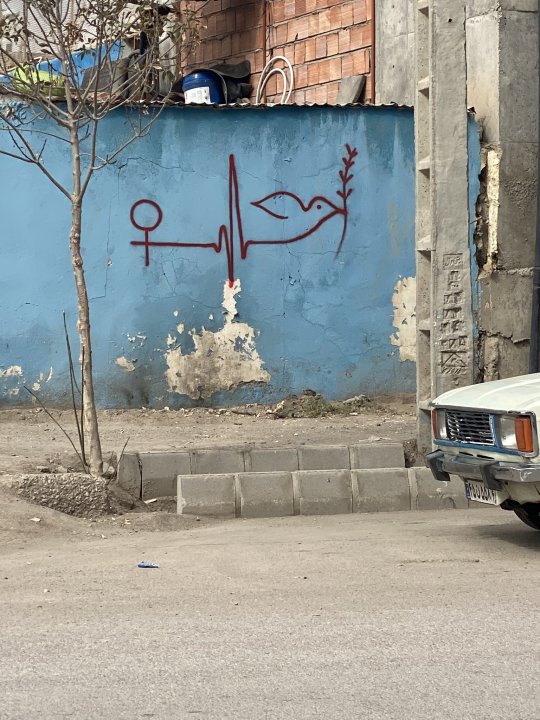
Pictures on the walls: Faces of our fallen martyrs. Anti regime pictures. They read: "you kill our love, you are our ISIS" "women life freedom" "women of Iran and Afghanistan against the violence of Talib and mullah" "fuck compulsory hijab" "from 2017 to 2022 this regime would fall like dominos" "ambu-lice (ambulances are being used to move policemen)". A religious figure hide behind religion playing his anti riot forces. On an alley named Azadi (freedom) someone has written "there was so much bravery hidden in this land".
(It's important to know that in Iran, mullahs don't represent religion as much as they represent the regime. For 40 years the turbans have been the heads of political powers. Most of those mullah pictures are directly targeting Khamenei the supreme leader)
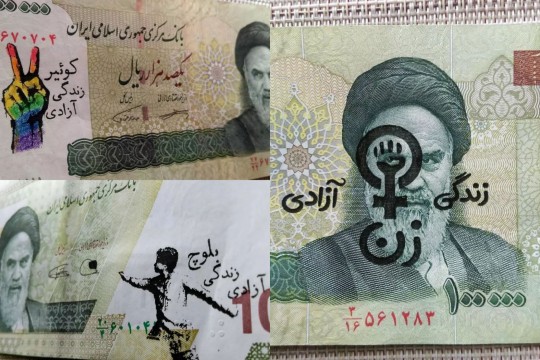
Slogans on paper money: these ones say "women life freedom" "queer life freedom" "Baloch life freedom".
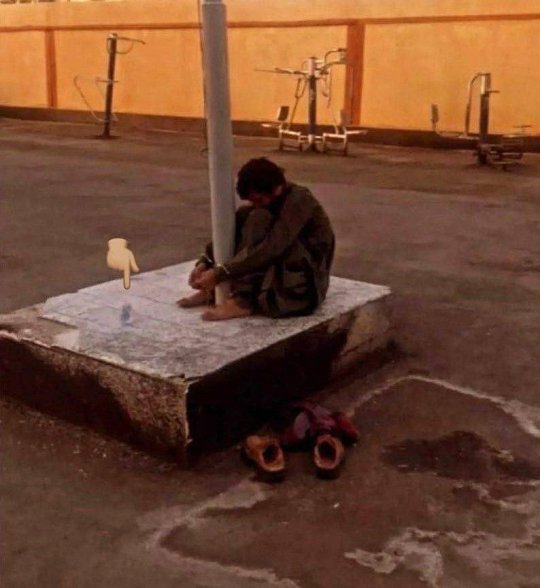
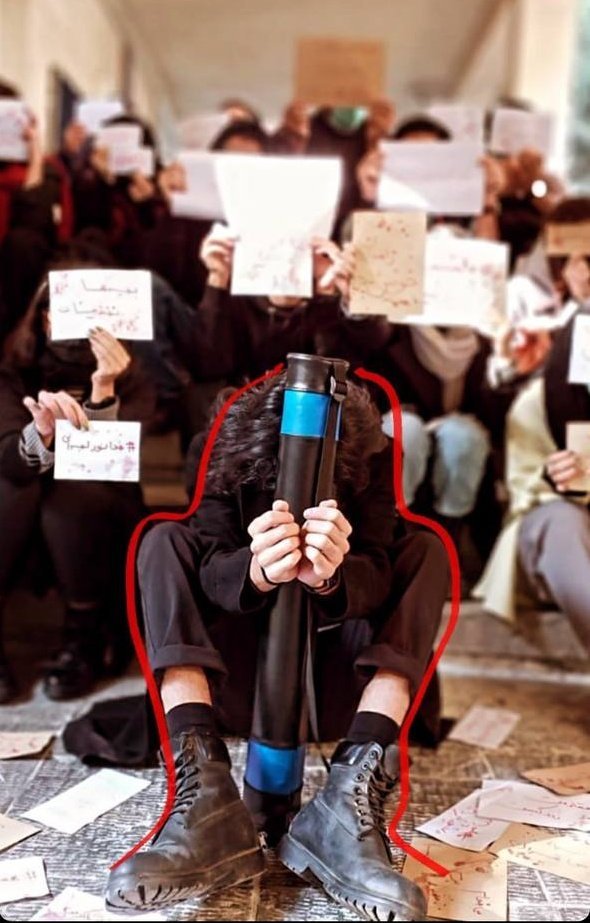
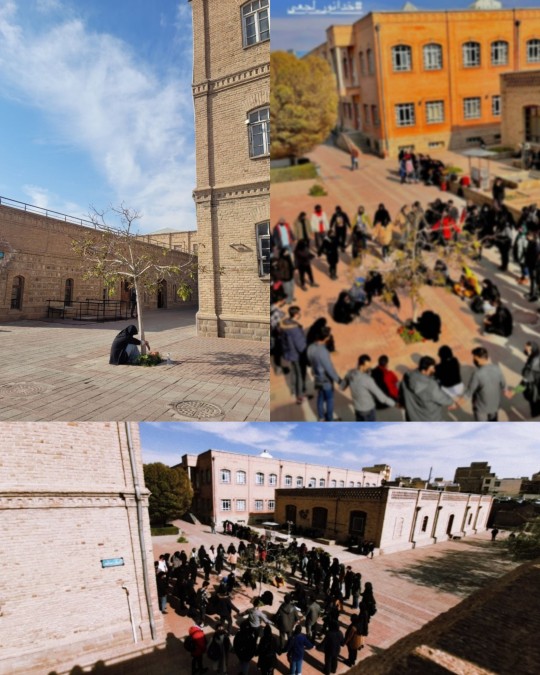
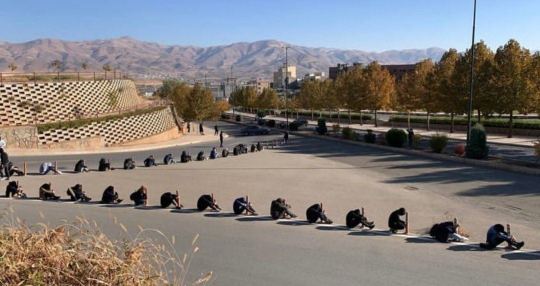
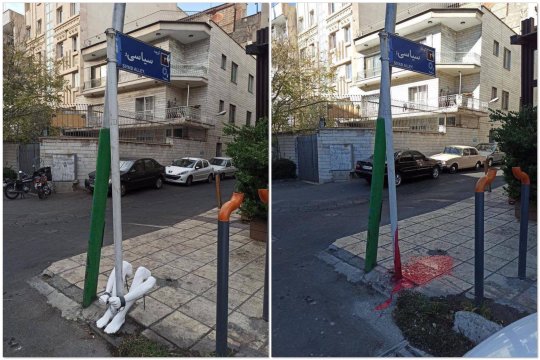
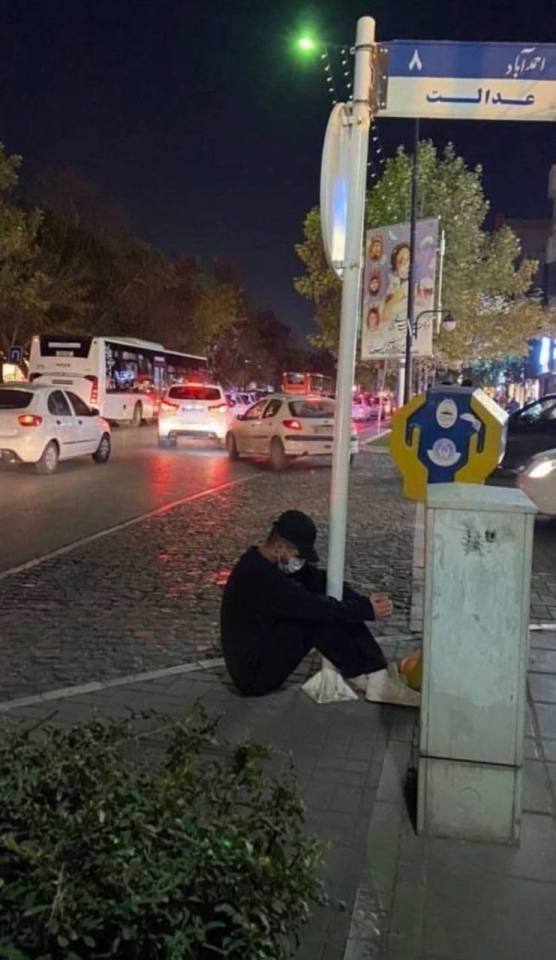
Khodanoor Lejei, symbol of the islamic republic cruelty: The bloody Friday in Zahedan was one of the darkest spots in Islamic republic brutal history. Opening fire on a crowd of praying Muslims before they even start protesting. Killing about 100 people of Baloch. But one picture stood out and stood as the face of inhumanity of the regime. Khodanoor Lejei was one of the victims of bloody Friday in Zahedan. An old picture of him went viral after his death. He was arrested a couple of months prior to Mahsa Amini murder and was treated with no dignity. Bound to a pole. water in front of his thirsty body but out of his reach. So in universities, sport games, streets and alleys people have been posing Khodanoor in bound to protest the cruelty. In the last two pictures, the signs read "political" (سیاسی) and "justice" (عدالت)!
Students sing revolution anthems. Artists make digital arts. Musicians make revolution songs. People dance and the security forces attack and arrest them.
There have been balloons flying over the cities with banners containing slogans on them. There have been banners on footbridges situated so that drivers would see them. People also have been writing slogans on billboards especially those that promote regime propaganda.

Azad university art students gathered in their campus, painted their palms red and raised their hands to the sky.

Meanwhile the regime forces broke into dormitories and stole students.
Some universities including mine design their campus trees and buildings with names of the murdered protesters or captured students and other revolution symbols (red tulip represents martyrs in Persian literature). The uni authorities take them down but the art students do it again.

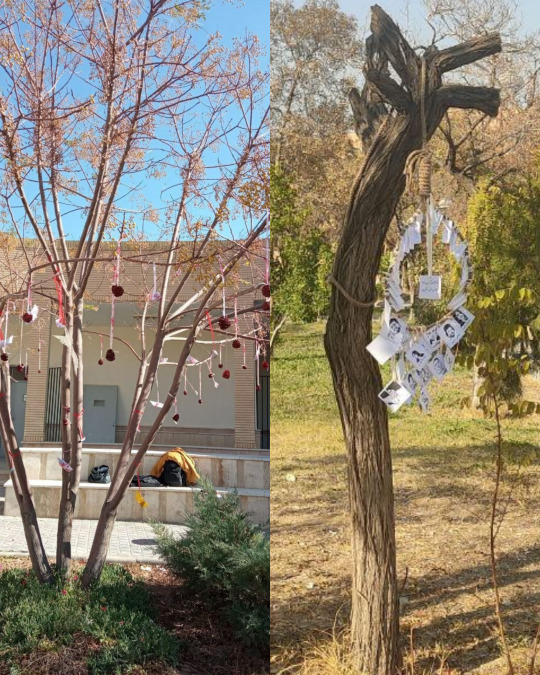
After Kian Pirfalak, all over the country you could find paper boats and rainbows. Kian was a 10 year old boy who was murdered by the regime. There's a video of him starting with "in the name of the god of the rainbow" and continuing to explain his crafted boat. He wanted to become an engineer. Now paper boats are banned in universities.
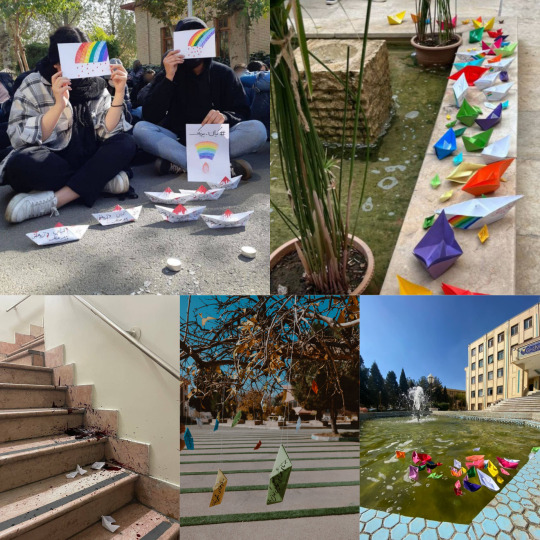

One of the murdered protesters, Hamidreza Rouhi, loved riding motorcycles. He had a video online of him on a motorbike lip syncing to a song and pointing to the camera. A group of motorbike riders in Tehran, 7 day after his murder, gathered in front of his house, their motorbikes lined nearby, with pictures of him on each bike.
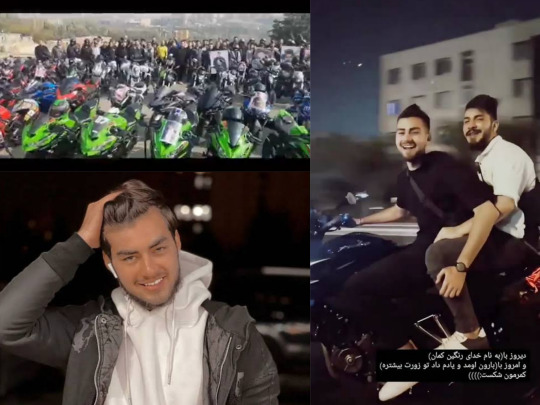
And in a recent symbolic act, a woman walked around Tehran streets as The Handmaid's Tale cosplayer. Very on point.

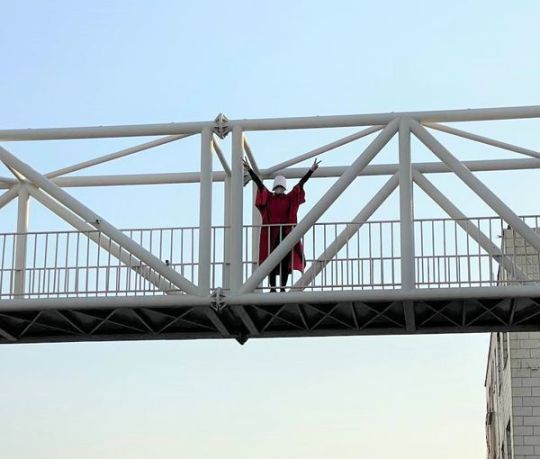
Don't think for a second that these civil ways of protesting are safe or easy. People have been arrested or shot in the head doing these.
People are capable of beauties but the regime can only make ugliness. That's the summary of this revolution.
#iran#mahsa amini#iran protests#iran revolution#politics#human rights#lgbtq+#feminism#intersectional feminism#art#revolution art#demonstration art#middle east#tw death#streetart#the handmaid's tale#civil disobedience
2K notes
·
View notes
Photo

Shulgi of Ur (r. 2029-1982 BCE) is considered the greatest king of the Ur III Period in Mesopotamia (2047-1750 BCE). His father was Ur-Nammu (r.2047-2030 BCE), who founded the Third Dynasty of Ur, and his mother was a daughter of King Utu-Hegal of Uruk (her name is not known) who first led the uprising against the Gutian occupation. Shulgi (also known as Culgi, Dungi, and Sulgi) inherited a stable kingdom after his father was killed in battle with the Gutians and proceeded to build upon his father's legacy to raise Sumer to great cultural heights. A literate man, he reformed the scribal schools and increased literacy throughout the region (among his greatest accomplishments) while also encouraging developments in musical performance as he was an accomplished musician. He allocated funds for the continued maintenance of the cities, improved the existing roads and built new ones, and even instituted the first roadside inns so that travelers could stop, rest, eat, and drink as they traveled (an innovation later adopted by the Persian Achaemenid Empire, c. 550-330 BCE). He also either instituted or continued the law code named for his father, the Code of Ur-Nammu, the oldest extant law code in the world. He declared himself a god during his lifetime and seems to have been worshipped by the people following his death. His reign is well documented as he had many scribes making inscriptions of his accomplishments but this documentation has been challenged on the grounds of inaccuracy. While it does seem clear that Shulgi reigned well, the majority of the documents relating to the details of his rule were those he ordered to be set down, including the famous A Praise Poem of Shulgi. Later chroniclers would accuse him of impiety and falsification of records, but the archaeological evidence seems to support his version of his reign fairly well. He is regularly credited with either initiating or encouraging the rebirth of Sumerian culture known as the Sumerian Renaissance.
40 notes
·
View notes
Text
You don't understand! I can't just start writing this fic! I'm only 70ish percent fluent in hangul, I still haven't verified whether the book I found about the formation of the Silk Road is up to date, I'm haven't gotten a new email back yet from the nice professor whose papers over pre Ottoman Empire dye fabrics was an absolute lifesaver, and I need to rewatch a YouTube musician explain/demonstrate the differences between ancient Persian, Indian and Egyptian music and instruments for the 10000th time.
#dreamer talks#personal#ao3 author#ao3#ao3 authors#I'm joking but I'm not#try and guess what fandom this fic was for#researching for a story/fic is fun#but all encompassing#writing#writing memes
30 notes
·
View notes
Text
Every sulken glance I'm a little more broken Our love was porcelain
#we were never in love it was only a dream#favourite songs#mareux#lovers from the past#love my fellow persian musicians to death#darkwave#coldwave#minimal synth#king woman#kristina esfandiari
71 notes
·
View notes
Text
youtube
To make a long story short - due to abuse reasons I only found out I was biracial and Mizrahi Jewish in my twenties and I could only come back to because I was so so sure I was not Jewish Enough, that I didn’t know enough. That being patrilineal meant I wasn’t.
But I remember listening to this and feeling as though I was home. In my soul, in my blood and bones - I was home. I am a biracial Mizrahi Jewish woman - Am Yisrael Chai - through my Persian and Syrian Jewish lines through my bio father, I am enough perhaps. And hearing a Persian Jewish musician sing, it made my heart ache and made me feel loved.
I am olive (trees and skin and..) and pomegranates and brown eyes and water and doves. I am a dancer with jasmine and roses twined in my hair and silk and cotton gowns. I am enough. I live. We live.
(I am my dads family too - those who lived in Poland once and then and then but I am Jewish)
#lils personal aesthetic#jewish biracial fairy princess me#jewish things#this is probably incoherent and sappy as fuck applogies#Youtube
88 notes
·
View notes
Text
Separatist Swaps: Home Cook Youtubers
This week’s theme from @radblrthemeweeks is Separatist Swaps (suggesting equivalent female artists/musicians/creators/etc to support as well as or instead of men)
I’ll admit I don’t read or watch TV much, but I do watch a lot of YouTube. I added some of my favorite channels to this post in the past (X). This will be an expanded list in no particular order.
Initially, I wanted to compare each channel to a similar male-led one, but I opted to just summarize what I think is unique about each one.
Food and Cooking
Note: I prefer vegan/plant based cooking, so I’ll specify which of these channels are exclusively vegan.
Cheap Lazy Vegan (V) Rose makes a lot of Korean food, but the ingredients are pretty easy to find at a regular grocery store. Many of her videos feature high protein, nutritious meals that can be ready in 20 minutes or less. I’ve also found her recipes to be shockingly simple without getting boring.
Rainbow Plant Life (V) Nisha is one of my favorite youtubers. Her recipes are a bit more involved that Rose’s, but I’ve made several of them myself so they’re still approachable for a home cook. Her recipes are primarily American or Indian inspired with advice for meal prep and saving time.
Pick Up Limes (V) Sadia is a nutritionist, so her recipes tend to be wholesome and nutritious. However, she still has a lot of recipes for comfort food and desserts. I don’t make her recipes as often, but her videos are enjoyable.
Sierra Ann I like her easy “recipes” (more like meal ideas), but she sometimes posts about fashion as well. Her content is more akin to a vlog than concrete recipes or cooking tips, so I find myself watching her YT shorts more than her longform content.
Lisa Nguyen I’ve only ever seen her YT shorts so idk if she makes longer videos or not. She does instant ramen challenges where she tries different brands or ramen hacks.
Morgan Drinks Coffee Morgan releases a mix of recipes and other content like appliance and coffee reviews. She has a lot of advice for people just getting into coffee or those who want some fresh ideas.
Inga Lam When I made the other post she was still working for Buzzfeed, but she recently decided to focus on her own channel. I’m not sure what she has planned but she’s very creative and ambitious.
How to Cook That Ann Reardon mostly makes baking videos, but I prefer her debunking videos. She seems to have shifted more toward debunking dangerous videos in general, not just food related videos.
June Xie from Delish June makes long videos creating a week’s worth of meals, often on a budget. My main complaint about her content is that some of the food she makes is either not for everybody or uses ingredients that aren’t readily accessible, like produce from specialty shops. However, that also means her recipes tend to be unique and interesting. Her boyfriend also comes off as kinda rude, but he’s only there when they’re tasting the food.
Beryl Shereshewsky People from around the world submit ways they eat a particular food, like instant ramen or onions, and Beryl makes and reviews them. These videos are helpful when I feel stuck in a routine and want to see ingredients from a different perspective.
Alix Traeger Alix used to work for Tasty, but now she makes content on her own channel with her girlfriend Zoya. Zoya is Persian, so it’s been fun watching Alix try to master Persian dishes.
Here are some others I saw in my Watch Later list that I don’t watch often or haven’t seen yet.
Mina Rome (Cooking)
Doobydobap (Cooking)
Flo Lum (Cooking)
Sarah’s Vegan Kitchen (Cooking)
Sweet Simple Vegan (Cooking)
Julia Pacheco (Cooking)
Feelgoodfoodie (Cooking)
Anne of all trades (DIY)
The busy brown angel (Gardening)
Gardening and Homesteading
Girl in the Woods I just found her channel last week, but it was too interesting to leave out. Usually I don’t like homesteading YouTubers because they focus on the aesthetics, but I’ve actually learned a lot about off-grid living just from watching a few of her videos.
HannahLeeDuggan She bought a property with a run-down cabin a few years back. Before that, she was living in a van and selling handmade clothes online. I can’t say I’ve learned much about van life or homesteading from her videos, but I haven’t given her a fair chance yet. Last I checked, she was planning on documenting the process of fixing up and weather-proofing her cabin.
Learn Something
Answers in Progress This channel is run by three people, two of which are women. They answer random questions with a surprising amount of research and interviews with professionals.
The Take The Take claims to be “ the leading female-led entertainment analysis channel on TV, Movies & Pop-Culture”
Cheyenne Lin Cheyenne focuses on feminist analysis and film analysis through a feminist lens.
Jessica Chou She isn’t active anymore but she has some basic videos on car maintenance.
Micarah Tewers Micarah sews a combination of beautiful and insane clothes. I’ve never tried to recreate any of her patterns but she’s so entertaining to watch. She made fake eyelashes out of her dog’s hair and that’s not even the craziest thing she’s done on her channel.
Since this is intended to be a discussion, I’m also including a list of channels I’d like to find that are usually male dominated.
Game News and Lore I like watching lore videos for games like the Fallout series, RDR2, and TES. So far, the only female gamers I’ve seen on YT are overly sexualized and don’t make the content I’m looking for.
Food Science There are a few channels that break down food science like Adam Ragusea and Kenji Lopez-Alt. The closest female equivalent is How to Cook That, but it’s not quite what I’m looking for and she primarily posts baking videos.
I’ve been watching a lot of Ethan Chlebowski’s videos lately because he makes meal formulas and focuses on high protein meals. If anyone knows who I’m talking about, I’d love to see female-run channels that make similar content.
Gardening and Homesteading I want channels that actually teach me something new and don’t focus on pseudoscience or religion.
423 notes
·
View notes
Text
A Little Bit of R&R (Ritenuto and Robitussin)
by fabalafae22
HEY YOU. YOU! Are you trying to distract yourself tonight for reasons we won't talk about? Or perhaps you just want to read a self-indulgent POTO sickfic about two grumpy middle-aged men? (Well, one of them is grumpy, and I'll let you guess who.) Here you go!
Read on AO3 (copy link to browser): https://archiveofourown.org/works/60346234
Rating: General Audiences Archive Warning: No Archive Warnings Apply Categories: Gen, M/M Fandoms: Le Fantôme de l'Opéra | Phantom of the Opera - Gaston Leroux, Le Fantôme de l'Opéra | Phantom of the Opera & Related Fandoms, Phantom - Susan Kay Relationships: Erik | Phantom of the Opera & The Persian, Erik | Phantom of the Opera/The Persian Characters: Erik | Phantom of the Opera, The Persian (Phantom of the Opera), Ayesha (Phantom) Additional Tags: Sickfic, Illness, Caretaking, Hurt/Comfort, Fluff, Fluff and Angst, Self-Esteem Issues, Body Image, Alternate Universe - Modern Setting, Ambiguous Relationships, Established Relationship, Friendship, Humor Words: 3,374 Chapters: 1/1
Summary: Erik has felt a little unwell all week. Unclear why, but a persistent ache in his shoulders, throat, and sinuses tells him something is amiss. For once, he decides to listen to his body's demands and do something about it.
Ritenuto, or "held back," is a musical notation instructing the musician to immediately slow down. Robitussin is a brand of cough medicine. R&R typically stands for rest & relaxation, or other synonyms that begin with R.
Notes: This belongs within my modern day Office Hours AU, in which Daroga and Erik are friends and colleagues. One day I'll post the big long story of Erik and Christine in that universe, but for now, please enjoy this teaser and self-indulgent sickfic!
Read on AO3 (copy link to browser): https://archiveofourown.org/works/60346234
#poto fanfiction#phantom of the opera#pharoga#erik/daroga#erik/the persian#poto#phanfic#phantom of the opera fanfiction#erik the phantom#the persian#poto fic#phic
7 notes
·
View notes
Text




Mountain Jews of Derbent, Dagestan, 1910s - 1930s
The Jewish population of Derbent and its surroundings are mainly descended from military colonies established by the Persian emperor Khosrow I in the 6th century. In addition, Khazar, Iraqi and Byzantine Jews settled in the city while travelling on the Silk Road. Speaking the traditional Judeo-Tat, the Derbent Mountain Jews were mainly involved in winemaking, madder cultivation and fisheries. They also excelled as horsemen, warriors and as folk dancers and musicians. After the collapse of the USSR, most of the Jews emigrated, with only a few hundred living in the city today.
129 notes
·
View notes
Note
absolutely gorgeous art. genuinely made me see the beauty in life.
and your writing? brother. (<- in tears)
one thing i want to ask you:
so we see Farkhad mainly through the Stamatin's view, i feel.
do you have any thoughts on Farkhad as a person? how he was as a kid? or a teenager? or is he for you only "existent" as an extension of the Stamatins? as this mysterious being... if you catch my drift.
THANK YOOUUU 🫶🫶🫶 very touched... the world is so beautiful and i can only try to approach its beauty. & more writing to come soon but this time it's evil.
and ok. ok. hehe. [1-frame glitch where i appear as an evil dog smiling] ok. hahaha héhéhé okay so basically.
farkhad's purposefully ambiguous to me, by me, through m(e/y telling of him). this is his design. this is paramount to his comprehension of him as a character to me. he is to me, but also to the real, lived and played, experienced narrative of the game, exclusively alive as an extension of the stamatins - it is them who give him (t)his game. there would be no farkhad without the twins, for it is them who named him this. he is nameless without them. however, and it is perhaps better articulated this way, more than being an extension of the stamatins... they are an extension of him. when i design him based on 18th-early 20th century persian portraiture it is because i anchor him, his physicality, in an art that predates the narrative, even his life as it is experienced by the twins. when i joke he was sculpted on the Achaemenid friezes, i mean it, when i joke he spoke(/speaks) ancient arameic by having been there when it was spoken, i mean it. and i don't. i'm fucking wit you and i'm not. this is what happened to the twins as well. this is something that i'm currently exploring in my current WIP but the way i conceptualize him is like..... a greek or roman myth. in the same way a character from greek & roman literature can have multiple stories of their births, multiple stories of who their parents are, multiple stories of what their symbols and associations are depending on the region, on the time period, on the people who worshipped and read (or despised and tried to burn out of the records); this is what he is happening to him.
i do believe he has a story, a place of birth, parents, even a sibling. I think he has a younger sister who resembles him a lot. where he is a sculptor and an architect and only incidentally is a musician, she is a musician by trade as well as a dancer. both of his parents were well-educated, relatively middle class. they also owned ancient art, which very young gave him his liking for creation. it was obvious he was gay as a child, in ways that translated in a great artistic potential, and his parents encouraged him in that path and kinda... pretended-to-not-see the gay thing, because they saw the artistic potential, and found himself having to accept that one influenced the other. i believe he is an Aquarius - this mysterious sign which appears to be of water, but is actually of air (this sign which is just before last: prelude of closing of the zodiac year, he is closing of everything around. he is the closing statement; everything comes after him).
and i don't.
you know what i mean?
#evil dog smile#THANK YOU FOR ASKING. TEEHEES AND GIGGLES.#ring ring (answers)#anonymous#farkhad#farkhad pathologic#fourfold bullet#threeandahalffold bullet#<- not really those two but there is other pertinent info in those tags methinks#oneirotects
18 notes
·
View notes